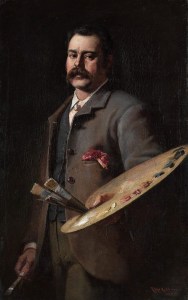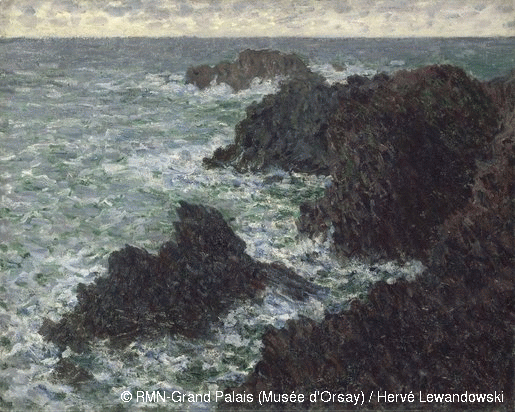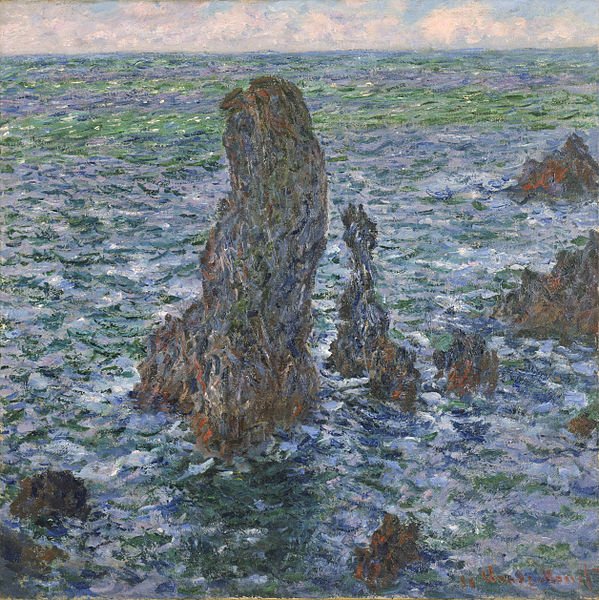
The other day, I was looking through a list of famous nineteenth and twentieth Australian artists. The compiler of the list believed that the greatestAustralian painters were Sidney Nolan, Peter Booth, Arthur Boyd, John Brack, Tom Roberts, Russel Drysdale, Frederick McCubbin, and John Olsen. I had heard of a number of these but what surprised me about the list was that it contained no female artists and so I decided to focus this blog on one such painter.

Emily Hilda Rix Nicholas was born on September 1st 1884, in the Australian city of Ballarat, some twenty-five miles north west of Melbourne. Her father, Henry Finch Rix was born in Woolwich, Kent on January 12th 1848, and her mother, Elizabeth Sutton, was born in Manchester, England in 1853. They had both emigrated as children with their families in the middle of the nineteenth century and the pair met and married in 1876. The couple had their first child, Elsie Bertha in 1877 and Hilda was born seven years later. Henry Rix was a mathematics teacher, an amateur poet and talented sportsman. He was a teacher at Bendigo, Ballarat and at Carlton. After a brief stint teaching in Ballarat, he was a mathematics master at Wesley College Melbourne for ten years between 1874 and 1884. He played for Carlton’s Australian Rules team and later became Inspector of Schools. In the book, A History of State Education in Victoria, Henry Rix was described as:
“…Of the men who have labored and passed away since 1900, Mr. H. F. Rix deserves to be especially remembered. Working under the result system, he foresaw the new day and strove to make it possible. His enthusiasm, his industry, his initiative, his research, and his sympathy made him a great inspector and a leader in educational reforms…”
Henry’s wife, Elizabeth, as well as being an accomplished singer, helped run a successful music business in Ballarat. She played an active part in the Austral Salon, a non-profit organization founded by a small group of women journalists in Melbourne in 1890 as a club for women writers. It then developed into a club whose aim was to introduce aspiring young musicians to an interested audience. She was also a talented amateur painter and had her own studio in Melbourne’s Flinders Street. Hilda and her sister Elsie being brought up in a musical household both learnt musical instruments and would perform at local shows. Elsie, like her mother, had a beautiful voice and performed at the Austral Salon. Hilda, as a small child, developed a love of drawing and painting and she and her sister would often design advertising posters for events at the Austral Salon.

Hilda attended Merton Hall High School, now Melbourne Girls Grammar School and although she was not an exceptional student she did excel in art under the tutelage of a Mr Mather. On leaving Merton Hall in 1902, eighteen-year-old Hilda enrolled on a three-year course at the National Gallery of Victoria Art School where one of her teachers was the foremost Australian Impressionist, Frederick McCubbin. Notwithstanding his standing in the art world, Hilda was critical of McCubban’s teaching style which she referred to as being “vague persuasions”. However her biographer John Pigot, in his 2000 book, Hilda Rix Nicholas: Her Life and Art, writes that the creativity of individuals rather than imitating the style of any one school of painting; he (McCubban) modelled the importance of nationalistic ideas and subjects that would become so prominent in her later painting and McCubban’s work emphasised the painting’s subject over technical considerations.

Hilda Rix’s work was so good that, although still a student, she had some of her drawings shown at annual exhibitions at the Victorian Artists’ Society and the Austral Salon. To earn herself some money she worked as a professional illustrator submitting her work for inclusion in textbooks and periodicals. Hilda was always with pencil and sketch pad and in her early days would persuade extended family members to sit for her whilst she sketched their portraits. Studies in two sketchbooks from her early years in Melbourne are now held at the National Library of Australia and in 2012 one of Rix’s early sketchbooks survives and pages from it were reproduced in Karen Johnson’s book, In Search of Beauty: Hilda Rix Nicholas’ Sketchbook Art

For most would-be artists who lived away from Europe such as Americans and Australians the Holy Grail was to visit and study art in Paris and London. Hilda’s father Henry decided to offer her a chance to sample the European art world and, in 1906, planned a family trip to England which, being as he was an educator, would also afford him the opportunity to study British education reforms. All his plans came to nought as Henry died that year, on February 27th aged just fifty-eight. His death at such a relatively young age precluded his widow from receiving a pension. After many discussions the family managed to cobble together money from an inheritance, money earnt from their rental income from their home, and finally money Hilda and her mother raised by selling off their many works of art and they were able to set sail for England early in 1907.

For Hilda, going to Europe to study art was only part of the solution to her improving her artistic skills, she needed to find a good teacher who was willing to tutor her. Before she left Australia, she spoke to Arthur Streeton, the Australian landscape painter who was the leading member of the Heidelberg School, which was also referred to as Australian Impressionism. He suggested that on arrival in London she contacted John Hassall, an English illustrator, who, in 1901, had opened his own New Art School and School of Poster Design in Kensington. When Hassall looked at Hilda’s work he was impressed by its quality and agreed to mentor her. She remained with him until the end of 1907 at which time, she, her mother and sister left England and travelled to Paris and rented an apartment in Montparnasse

In Paris Hilda made many friends who were involved in the art world, such as fellow Australian, Emanuel Phillips Fox. Fox had arrived in Paris in 1896 and enrolled at the Académie Julian, where he gained first prize in his year for design. The following year he trained at the École des Beaux-Arts where two of his tutors were William-Adolphe Bouguereau and Jean-Léon Gérôme, who were considered the greatest artists of their time. He returned to Australia in 1890 but returned to London after receiving a commission to paint a scene of the landing of Captain Cook in Australia, which had the strange caveat that he must paint the work abroad.

The 1902 painting, The Landing of Captain Cook at Botany Bay, 1770, depicts a wholly European perspective on the inauguration of relations between the British visitors and the local Aboriginal men of Botany Bay. In a post-Federation display of nationalistic projection, it shows Captain Cook stepping onto Australian land as part of a shore party, heroically interceding between the threatening local men who brandish spears and his own marines who aim to shoot them.

Hilda Rix also met Fox’s wife, Ethel, an English-born Impressionist and Post-Impressionist painter.
In Paris Hilda enrolled at the Académie Delécluse, operated by academic painter Auguste Joseph Delécluse. It was an atelier-style art school which was very supportive of women artists, and, in fact, it allotted more space to women students than to men. Men and women were trained separately, and it had two studios for women and only one for men. It was an extremely popular place to learn, especially among English and American women artists. At the height of its popularity, it was one of the four best-known ateliers in Paris. From this artistic establishment, Hilda moved to the Académie de la Grande Chaumière, where one of teachers was the Swiss-born illustrator Théophile Steinlen. She also studied at Académie Colarossi. It was around this time that Henri Matisse had a studio in the French capital and, as was the case with other professional artists, he also sometimes attended Colarossi’s to gain access to their models which he could use, free of charge, for his work. Matisse would also open the door of his studio to aspiring artists whom he would offer tuition and have them experiment with the techniques of Post Impressionism. It could well be that this is where Hilda first met Matisse.

Whilst living in Paris, the family would travel to Italy and other parts of France including Étaples, the fishing port in the Pas-de-Calais department in northern France which was so popular with artists. In 1909 Hilda Rix met and became very friendly with a Dutch architecture student Wim Brat. Their initial love ended when Hilda realised how her fiancé was a “mother’s boy” and was completely dominated by her, a woman who strongly disapproved of Hilda. Inevitably, Hilda broke off the engagement. Notwithstanding this personal setback, Hilda continued with her painting and exhibited her work at the 1911 Paris Salon. The painting, Return of the Hunt, was completed by Hilda in 1911 and depicts a woman on horseback in chocolate brown leather gloves with a large hare slung over her back.

Hilda Rix, accompanied by her sister and mother, took up residence in the rural art colony of Étaples the summer of 1910. Here she met Henry Ossawa Tanner, a well-established American artist in France, who was viewed as one of the leaders of the Étaples artists’ colony and a member of the art organization, the Société Artistique de Picardie. It was not just France and Italy which seduced artists, many started to cross the Mediterranean to paint and sketch in North Africa. Hilda Rix made two painting trips to the African continent. The first was in January 1912 when she travelled with a group of artists, including Henry Ossawa Tanner, and his wife, who were visiting Morocco via Madrid, Cordoba, and finally Algeciras, they had hoped to take a boat to Tangiers but the weather was too bad, which forced the travellers to Gibraltar for what proved a rough crossing to the Moroccan port.

Tanner being an African American and Rix being a female made them unconventional and exceptional travel and work companions on this journey. They stayed in Tangier and the northern port town of Tétouan. Matisse and Hilda Rix stayed in the Grand Hôtel Villa de France for most of February and March. They both painted views from the windows of their rooms at the hotel. Both of them worked on portraits and would use the same models and utilised an unused room in the hotel which the owner allocated to them. The room became a temporary studio space.

An example of the similar portraiture was Hilda’s painting, Hamido Sleeps and Matisse’s work, Moroccan Amido. In both cases the young model was a stable-hand at their Tangiers hotel.

In Matisse’s painting the young man stands easily and naturally, his slim long-legged form is emphasised by the narrow canvas format the artist has used. In the painting, Matisse captures the dark skin, the bright white shirt, the pure colours of the waistcoat and short trousers.

Hilda loved Tangier and spent hours sketching and painting in the open-air markets. She wrote home about how she loved Tangier and its market, writing:
“…Picture me in this market-place – I spend nearly every day there for it fascinates me completely – have done 16 drawings and two oil things so far – Am feeling thoroughly at home now so am going to take out my big oil box – wanted to get used to people and things first – Oh how I do love it all! … Oh the sun is shining I must out to work…”

Hilda Rix was fascinated by the buying and selling in the marketplace as well as the multitude of colours of the clothes worn by the people. In a letter home, dated February 12th 1912, she wrote:
“…”See how most of them are covering their faces – They have mostly cream draperies & perhaps orange waistcoats and little tight mauve green trousers – (tight at ankle) – Some may be wonderfully dressed under[neath]…”.
In a postcard she sent home a week later she wrote:
“…’Picture me in this market-place – I spend nearly every day there for it fascinates me absolutely – Have done 16 drawings and two oil things so far – Am feeling thoroughly at home now so am going to take out my big oil box – wanted to get used to people and things first – Oh I do love it all! …”
…………………..to be continued.







